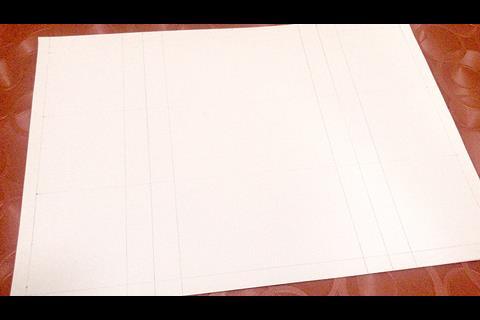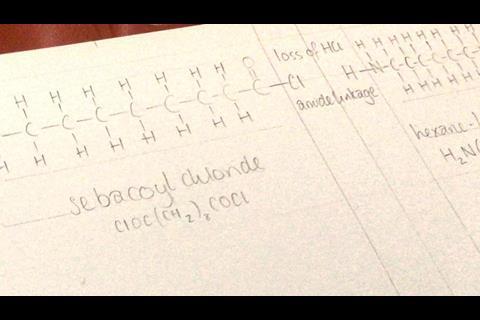When and how foldable paper prompts can help your students grasp complex topics

Many of my 14–16 students struggled to understand the formation of condensation polymers. Dealing with monomers far greater in size than they had met so far in their study of esterification was overwhelming. And translating what was on paper to the real world was proving to be a barrier. The simplification of the monomers used to make nylon into boxes (in the form that exam boards expect, ie -[A]-(C=O)NH-[B]-NH(C=O)-) was lost under the cognitive load. I needed something to make the content less abstract, that could also bring their attention back to the reaction that was taking place at the ends of the monomers. That was when foldable paper prompts, or foldables, were born.
Using foldables
Foldables have proved so popular among my 14–16 students, I now use them for post-16 polymerisation. They lend themselves extremely well to more complicated polymers such as Kevlar and polypeptides. They’re also really useful for differentiation when studying balancing equations with 14–16 classes. For example, if a student needs a little more support with one equation from a homework set, I can hide extra information in the folds, and they enable me to use dual coding to close the gap (quite literally!).
Before introducing a foldable in the classroom, I teach the content and review the learning objectives with any necessary interventions. Then I use a show-and-tell approach to introduce the foldable. I give my students colour copies of the foldable as flat sheets, and I also let them pass around my original so they see how they work. Next it’s time to try them out. Select some past paper questions and let the students tackle them with their foldables. You can simply stand back and watch the ripple of pennies drop as they wrap their heads around the content. It’s a lovely moment to experience.
Foldables are also a useful tool for revision. Students make a 60-second presentation to explain a chemistry topic, using a foldable as the prop. They then share their presentations on a platform like Google Classroom – great for the students, and also great for me as it’s effectively a mixtape of revision resources to use for years to come.
Making foldables
Each foldable template takes me around an hour to create, but allow yourself more time until you get accustomed to them. I like to use a sharp pencil and keep an eraser to hand. Fibre-tip pens make the work look smart, but I use pencil first in case of mistakes. You might think that card would be a good idea, for durability, but I find the folds aren’t crisp enough. Ordinary paper, plain, squared or graph, is my preference.
The first step is to ‘think’ in 3D – how do you wish the final sheet to look? If you only want one hidden section, your foldable will resemble a leaflet (/\/\). For the time invested in designing and making the foldables, concepts that require two or three hidden sections make it worthwhile: (_/\/\_/\/\_) or (_/\/\_/\/\_/\/\_). More than four and they’re too difficult to handle.
Start by marking the borders around the edges and where you want the folds to go (A). Each fold requires two ‘hills’ (_/\/\_). You’re then ready to include your topic (B). Draw and write the structures, adding any dual coding you feel is helpful, but limit the writing to essential information only, as it can distract. I draw additional lines to guide my writing and keep everything evenly spaced. Ink can blot on the creases, but you need to fold the sheet to ensure the bonds/arrows align (C), so use ballpoint pen to avoid blotting. You can go over it with a fibre-tip pen once you’re happy. I recommend using clean, unused sticky tape on the folds and ironing them to make them crisp.
You can make your own foldable using these tips, and you can find more foldables at Origamiorganelles, where there are also short presentations and a teacher’s guide on using them in your teaching. Happy folding.
You can make your own foldable using these tips, and you can find more foldables at Origamiorganelles (bit.ly/3cghdRc), where there are also short presentations and a teacher’s guide on using them in your teaching. Happy folding.
If you are on Twitter tag @RSC_EiC and @KnightbusSci on any photos of your foldables, we’d love to see them!
Faisal Khan












2 readers' comments